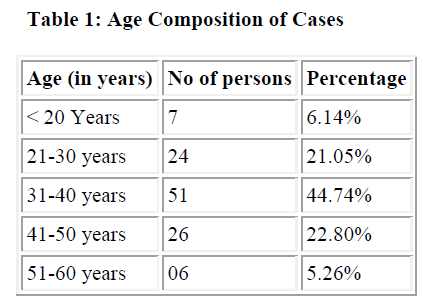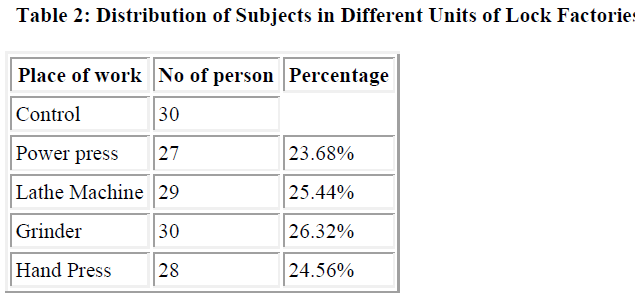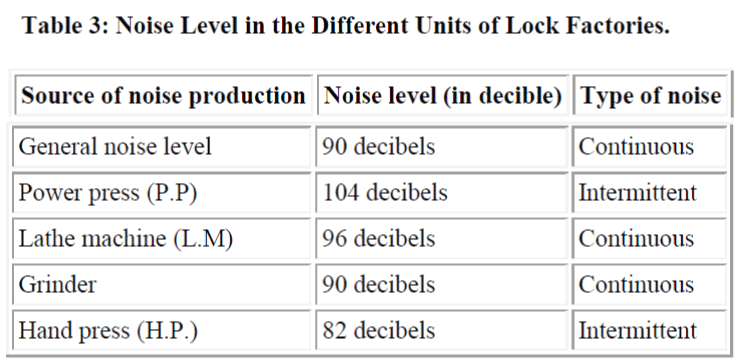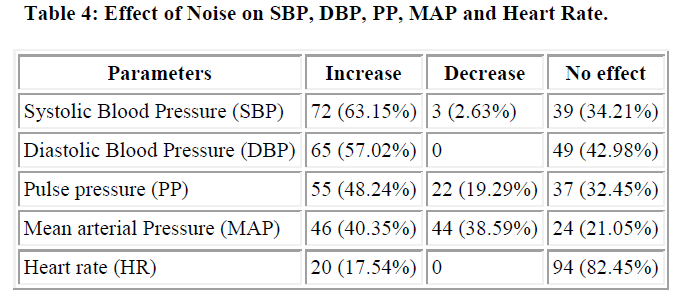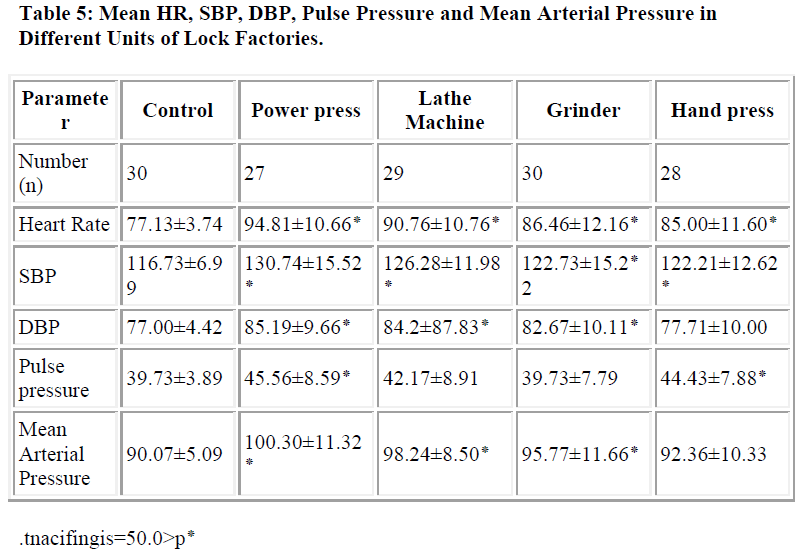ISSN: 0970-938X (Print) | 0976-1683 (Electronic)
Biomedical Research
An International Journal of Medical Sciences
- Biomedical Research (2009) Volume 20, Issue 2
Effects of workplace noise on blood pressure and heart rate
*Department of Otorhinolaryngology, J.N. Medical College, Aligarh Muslim University, Aligarh, India,Department of Physiology
**milsuM hragilA ,egelloC gnireenignE .H.Z .gnireenignE lacinahceM fo tnemtrapeD,University, Aligarh, India
- *Corresponding Author:
- Sangeeta Singhal
Department of Physiology
J.N.Medical College
Aligarh Muslim University Aligarh -202001, U.P., India
Accepted March 10 2009
Environmental noise is a known stress, which induces alterations of various physiological responses in individuals exposed to it. The aim of the present study was to assess the effects of industrial noise on the cardiovascular system of workers exposed to industrial noise in lock factories. The study group included 114 workers employed in different sections of lock factories exposed to industrial noise levels exceeding 80 dB. The control group consisted 30 people who never lived or worked in a noisy environment. The results of this study showed significant changes in systolic blood pressure, diastolic blood pressure, mean arterial pressure, pulse pressure and heart rate in the workers of lock factories. So this indicates that industrial noise could be possible contributing factor in the development of arterial hypertension.
Keywords
Industrial noise, systolic B.P., diastolic B.P., heart rate
Introduction
The term noise is commonly used to describe sounds that are disagreeable or unpleasant produced by acoustic waves of random intensities and frequencies [1]. Some authors define noise as any audible acoustic energy that adversely affects the physiological or psychological well being of the people [2]. Noise pollution is becoming increasingly more severe in industrial countries and the cost of alleviating it in future years is expected to be insurmountable.
Prevalence of noise is implicated in various illness of human and it is responsible for increased morbidity associated with modern life style. Immediate and serious attention must be given to control this mushrooming problem, since the overall loudness of environmental noise is doubling every ten years [3]. This has encouraged scientists to discuss and study the effects of noise pollution on human’s health. The Federal Occupational safety and Health Act (OSHA) administrated by the U.S. Department of Labour, requires that specified noise exposures not be exceeded. Excessive noise pollution has been blamed not only for hearing damage and community annoyance but also for hypertension, fatigue, heart trouble, disturbed serum lipid, triglycerides, platelet count, plasma viscosity, glucose and reduced motor efficiency [4]. Many studies have shown that noise influences the cardiovascular, endocrine, metabolic, gastrointestinal and neurological systems [5]. The cardiovascular system is considered to be the most involved and therefore has received the most attention, where as few specific studies have been performed concerning the relationship between noise and myocardial disease. There is evidence that noise presents a significant factor in the genesis of arterial hypertension coronary disease [7], and disorders of peripheral arterial circulation [8].
Evidence that links noise exposure to chronic changes in blood pressure and heart rate can be found in both animal and human studies [9]. Some noise experts have investigated the acute affects of short term loud noise on blood pressure and other cardiovascular parameters. Most of the studies have shown a rise in systolic and/or diastolic blood pressure [10,11], while some of the research scientists observed negative (decreased or non-significantly increased) association between blood pressure and noise
As no work has been done on the effects of noise on the cardiovascular system of workers of lock factories, therefore, we designed this study to evaluate the influence of noise exposure on blood pressure and heart rate of people working in lock factories of Aligarh. There is evidence that by the use of appropriate preventive measures, the harmful effects of noise could be moderated and even eliminated [6].
Materials and Methods
The present study was conducted on 114 subjects of both sexes from various lock factories in Aligarh during the year 2006 to 2007. The study was conducted in the Department of Physiology of Jawaharlal Nehru Medical College, Aligarh Muslim University, Aligarh and in the different sections of the lock factories of Aligarh.
Selection of Cases
Criteria for selection of the subjects in this study were:
1. Subjects were working in different sections of lock factories.
2. Subjects having no history of hypertension.
3. Subjects having no history of myocardial infarction.
4. Subjects having no history of head injury with unconsciousness.
Control Cases
The control group consisted of 30 subjects taken from the out door patient Department of Otorhinolaryngology, students and staff of Physiology Department of Jawaharlal Nehru Medical College, A.M.U., Aligarh and from the general population of Aligarh who were not exposed to any noisy environment. All the control cases were within the age group of 16-55 years with mean age 33.40 ± 10.41 years. Their mean height was 159.97 ± 6.15 cms and their mean weight was 57.87 ± 8.91 kg. Among controls 24 were males and 6 were females.
Test Cases
The test group included 114 workers of both sexes employed in different lock factories of Aligarh, exposed to industrial noise. The age of the subjects was in the range of 16-58 years with mean age 35.74 ± 9.14 years. Their mean height was 162.16 ± 6.09 cms and their mean weight was 54.78 ± 8.68 kg. Among test cases 101 were males and 13 were females. The subjects were thoroughly examined and investigated. So the controls cases and test cases were matched according to the age, height and weight.
Subjects were exposed to noise for 8 to 10 hours per day with a break of half to one hour for lunch and one weekend holiday
Measurement of Noise Intensity
The intensity of noise was recorded by sound level meter (LEUTRON SL-4001 digital) in all sections of lock factories namely Power press unit, Lathe machine, Grinder and Hand press unit. The sound level meter was portable one which measured sound between 35-130dB, with resolution of 0.1dB.Noise level was recorded after the sound level meter had been calibrated. Same instrument was used every time during the complete study.
Measurement of heart rate
The heart rate was recorded as per standard procedure of medical examination given in Hutchison’s Clinical Methods [14]. The subjects were allowed to relax so that any tachycardia due to nervousness in the subjects was subsided. The forearm of the subject was slightly pronated and the wrist slightly flexed. The radial pulse was felt with the tips of the fingers compressing the vessel against the head of the radius. The rate of the pulse was noted in beats per minute. The beats were counted for full one minute.
Recording of systemic arterial blood pressure
Blood pressure was measured in supine position by using mercury sphygmomanometer (Pagoda, Elite Surgical Industries). Systolic blood pressure (SBP) and diastolic blood pressure (DBP) of all the subjects were recorded. Mean arterial pressure and pulse pressure was calculated from the above data.
Mean arterial pressure = Diastolic BP+1/3 Pulse pressure
Pulse pressure = Systolic BP – Diastolic BP.
Statistical Analysis
Results were analyzed by Student t-test using SPSS-16 package.
Results
All the subjects selected in this study were in the age group of 16-58 years of range. Table 1 shows the age composition of the subjects working in different lock factories. It shows that the maximum number of workers were in the age group of 31-40 years. The subjects were screened from different places of different lock factories in Aligarh. The distribution of workers in different units of lock factories is shown in Table 2. 30 subjects were taken as control, who were not exposed to industrial noise.
The measurement of noise pollution level and its nature at different locations represented by different sections of lock factories are given in Table 3. The maximum level of noise was in Power Press unit, subsequently followed by Lathe Machine, Grinder and Hand Press unit. When the blood pressure was analysed in the subjects, the statistical analysis of the data showed that the systolic blood pressure (SBP), diastolic blood pressure (DBP), Pulse pressure (PP), and mean pressure (MP) increased in 63.15%, 57.02%, 48.24% and 40.35% of total subjects respectively and the above parameters decreased in 2.63%, 0%, 19.29% and 38.59% subjects respectively. No effect on SBP, DBP, PP and MP was observed in 34.21%, 42.98%, 32.45% and 21.05% subjects respectively. The heart rate was increased in 17.54% of all subjects. The numbers of subjects in whom the blood pressure increased, decreased or was not affected is shown in Table 4.
Table No. 5 shows the average values expressed as group mean ± standard deviation (SD) of various parameters like heart rate, SBP, DBP, PP and mean arterial pressure in various sections of lock factories. The data were analysed using the SPSS program. Analysis of significance by student t test was used to compare the different parameters of the workers in Power Press, Lathe Machine, Grinder, Hand Press units with the control subjects.
The values were significant for systolic BP and heart rate in all the units of lock factories and it was significant for diastolic BP and mean arterial pressure in all units except Hand Press but the values were significant for pulse pressure in Power Press and Hand Press units only.
Discussion
Noise pollution is increasingly being recognized as a physical factor in the environment that is injurious to many aspects of health. Our result showed a significant increase in systolic blood pressure, diastolic blood pressure and heart rate in all the different units of lock factories (Table 5). Many research scientists in the world have observed a significant rise in blood pressure in response to noise [15,16,17].
Some of the scientists observed a rise only in systolic B.P. [18,10] while many others found a significant increase in both systolic and diastolic B.P. in response to noise. Babisch [19] could not see any association of noise and blood pressure, whereas Elise, Kempen V, Kruize H, Hendrick C, Boshuizen, Caroline B et al [20] observed insignificant increase in blood pressure.
The actual mechanism for increase in blood pressure is not yet completely understood but it may be due to the following mechanism: The catecholamines released from adrenal medulla as a result of activation of adrenergic system, the effect of suprarenal glands steroids, angiotensin and also the direct effect of noise on arterial wall tension influences the blood pressure and heart rate [21]. Stimulation by noise, through sympathetic nervous system, causes an elevation of blood pressure by an increase in total peripheral resistance and myocardial contractility The repeated stimulation with noise could then accelerate the development of structural vascular changes in the peripheral resistance vessels and by this mechanism create a permanent blood pressure elevation to hypertensive levels [11].
Table 5 shows systolic B.P., diastolic B.P. pulse pressure, mean arterial pressure and heart rate significantly increased in power press unit with 104 dB noise level, whereas systolic B.P., diastolic B.P., mean arterial pressure and heart rate increased significantly in Lathe Machine unit with 96 dB noise level. Systolic B.P., diastolic B.P., mean arterial pressure and heart rate increased significantly in Grinder unit with 90 dB noise level and only systolic B.P., pulse pressure and heart rate increased significantly in Hand Press unit with 82 dB noise. So it is seen that all the parameters are significant in Power Press unit which has maximum noise level while only 3 parameters are significant in Hand Press unit which has minimum noise level. So it is concluded that higher is the noise level, higher is the number of workers with hypertension Previous study made by Uday, Bhooshan, Thakre [23] showed similar results.
These results show that industrial noise cause disturbance of cardiovascular system of the exposed workers so effective actions should be taken to prevent or minimize the effects of noise at workplaces. Efforts should be made to control the noise at the source, to control the transmission of noise and to protect the exposed persons. There should be permanent arrangements for regular measurements of noise levels at different locations in cities and factories and health education regarding noise control should be given due importance.
References
- Akhtar HN. Noise-induced hearing loss in traffic police constables. J Coll Physicians Surg Pak 1996; 6: 265-268
- Kryter KD. The effect of noise on Man. New York. Academic Press 1985; pp 389-393.
- Chedd, G, 1970. Sound from communication to noise pollution. Science 1981; 211 (4489): 1450-1452.
- Regecova, V. and E. Kellerova. Effects of Urban noise pollution on blood pressure and heart rate in preschool children 1995. J. Hypertension, 13: 405-412.
- Anticaglia. J, Cohen A. Extra-auditory effects of noise as a health hazard. Am Ind Hyg Assoc J 1970; 31: 277-281. Effects of workplace noise on blood pressure and heart rate
- Jovanovic J. Effects of constant industrial noise on cardiovascular system of industrial workers, Doctoral thesis, Univ of Nis 1990.
- Cuesden L. Teganeann S, Tutus, Raiciu M, Sarp C, Coatu S. Study of cardiovascular and auditory pathophysiological implications in a group of operatives working in noisy industrial surrounding. Physiologie 1977; 14: 53-61.
- Borg E. Physiological and Pathogenic effects of sound. Acta Otolaryngol 1981; 5 (Suppl 381): 1-68.
- Peterson EA, Angenstein JS, Tomis DC. Noise raises blood pressure without impairing auditory sensitivity. Science 1981; 211 (4489): 1450-1452.
- Germano G, Damiani S, Milito U, Giarrizzo C, Santucci A. Noise stimulus in normal subjects: time dependent blood pressure pattern assessment. Clin Cardiol 1991; 14: 321-325.
- Smookler HH, Geobel KH, Siegel MI,Clarke OE. Hypertensive effects of prolonged auditory, visual and mution stimulation. Fed Proc 1973; 32: 2105- 2110.
- Green MS, Schwartz K, Harari G, Najenson T. Industrial noise exposure and ambulatory blood pressure and heart rate. J Occupt Med 1991; 33: 879-883.
- Kristal-Boneh E. Acute and chronic effects of noise exposure on blood pressure and heart rate among industrial employees. Arch Environ Health 1995; 50: 298- 304.
- The Cardiovascular System (Ch-9) in Hutchison’s Clinical Methods. 18th ed.ELBS., Great Britain 1985: pp 198-263
- Herbold M, Hense HW, Keil U. Effects of road traffic noise on prevalence of hypertension in men. Soz Praventivmed 1989; 34: 19-23.
- Mahmood R, Ghulam JH, Alam S, Safi AJ, Salahuddin, Amin-ul-Haq; Effect of 90 decibel noise of 4000 Hertz on blood pressure in young adults. Noise Pollution 2007; 4: 1-4.
- Mollar AR. Noise as a health hazard. In: Maxy Rossenau Public health and preventive medicine. 11thed. New York, Appleton Century Crofts 1980; 790-799.
- Evans GW, lerchar P, Meis M, Ising H, Kofler WW. Community noise exposure and stress in children. J Acoust Am 2001; 109: 1023-1027.
- Babisch W, Ising H, Gallacher JE, Sharp DS, Baker IA. Traffic noise and cardiovascular risk, first phase. Arch Environ Health 1993; 48: 401-405.
- Elise EMM, Kempen V, Kruize H, Hendrick C, Boshuizen, Caroline B et al. The association between noise exposure and blood pressure and ischaemic heart disease, Environ Health prospect 2002; 110: 307-317.
- Andren L, Hanson L, Bjorkman M, Jonsson A. Noise as a contributing factor in the development of elevated arterial pressure. Acta Med Scand 1980; 207: 493- 498.
- Andren L. Cardiovascular effects of noise. Acta Med Scand 1983; 5 (Suppl 657):
- Uday WN, Bhooshan G, Surjase and Sushama S. Thakre. Hypertension and hearing impairment in workers of iron and steel industry. Indian J Physiol Pharmacol 2006; 50: 60-66.
